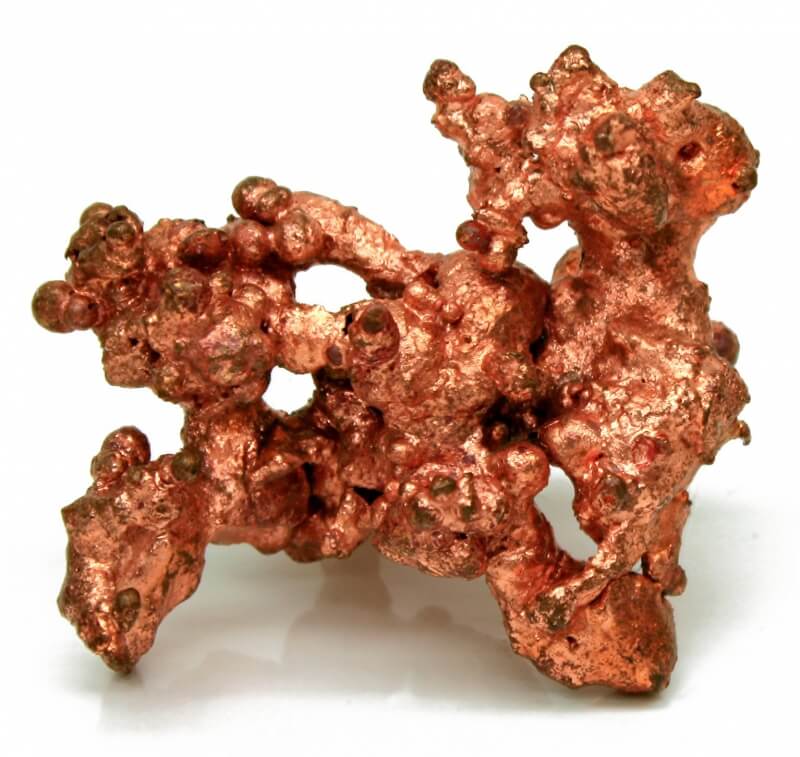By Tyler
Rusnak
One
of the most fundamental and often underappreciated characteristic of numismatic
objects is the material it is made out of. However, the science behind metals
(its chemistry, physics, and metallurgy) can explain many of the unique
characteristics of the coins we study, as well as offer an interesting
digression from typical numismatic study. With this in mind, and a casual
interest in mineral collecting as well, I thought I could explore this new
tangent with regards to some of my favorite coins, including Early American
coppers. Understanding the basis and namesake of these base metal coins,
copper, presents an entirely new view of their history and origins.
To
start off with some basic physical properties, copper is the 29th
element on the periodic table of the elements and has a mass of 63.55 AMU
(Atomic Mass Units). The symbol
representing copper on the periodic table, Cu, actually stands for Cuprum, which is a Latin shortening of
one of its first names, Cyprium.
Copper was so called because of its origin. In ancient times, the first major
source of copper in the Mediterranean world was found on the island of Cyprus,
located just south of present day Turkey and, ironically, home to one of my
other major collections. In any case, these were the very mines that supplied
the Roman Empire with copper and subsequently graced the metal’s name with the
island’s name. Today, of course, many more sources of copper exist, including
mines in Chile, Utah, New Mexico, Mongolia, and, of local interest to me, in
Michigan’s Upper Peninsula. For many years now my family and I have vacationed
up to a few beautiful spots on the western edge of the peninsula, a place with
a fascinating geologic history and many derelict mines. Only a few decades ago,
the area was home to some of the largest mines, containing some of the purest
native copper, in the world; it has since become more costly than other
(especially international) sources and shut down. However, there is still an
active mineral collecting scene there, as well as a company that operates out
of the Caledonia copper mine near Ontonagon, Michigan, that lets tourists and
collectors purchase copper ore piles and take home beautiful native copper
specimens. Every time I visit, I buy one of these piles and inevitably find
pounds and pounds of native copper to take home.
For
as long as copper has been mined, copper has been used in decorations, jewelry,
coins, weapons, machines, and modern electronics. Much of its unique beauty
comes from the fact that it is one of only four non-silver/gray metals, the
other three being gold (yellow), Cesium (yellow), and Osmium (deep purple). In
addition to its aesthetic uses, copper, which is second in electrical
conductivity only to silver, is also used extensively in electronics and wiring
due to its high conductivity (and relative inexpensiveness compared to silver).
The metal also has a wide variety of uses due to its hardness, or rather its
lack thereof, its ability to be alloyed, and its durability. Copper is a very
soft and thus easily workable metal, and only slightly less so than gold.
However, it can be alloyed, or mixed, with other metals in order to harden and
strengthen it. For example, bronze, an alloy of copper that contains a small
percentage of tin and zinc, has been used in American numismatics to coin the
likes of the Indian Head penny, most wheat pennies, two-cent pieces, and numerous
other coins and tokens. Brass is another such alloy made with varying levels of
zinc while cupronickel, which is almost ubiquitous in modern coinage, is copper
alloyed with nickel. The composition of Early American copper coins, however,
is highly variable thanks to the early mint’s difficulty with obtaining
reliable sources of copper. Often, the early mint had to buy and melt copper
scraps or other copper coins in order to mint their coins, and thus EAC’s are
often riddled with impurities that manifested in different striking qualities,
unique patterns of corrosion, and more. Although these coins are more often
than not found oxidized and corroded due in part to their age and heavy use,
copper is a generally unreactive metal and is durable as a coining metal, hence
its widespread use as such.
From
the mine to the factory to the mint, copper remains a fascinating and robust
element. Understanding where it comes from and the science behind its physical
properties reveals much about the coins made of such a metal. Thus I urge every
numismatist to stop every now and then to consider the metallurgical aspects of
their collections with the hopes that knowing more will help to breed a deeper
sense of appreciation and understanding of these wonderful numismatic objects.
